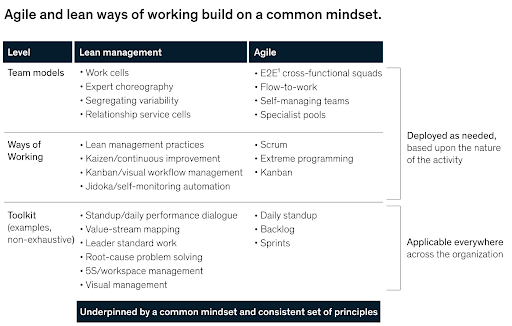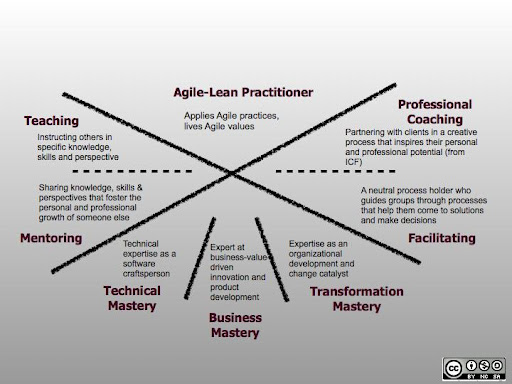
What is a lean-agile coach?
Optimising and updating an organisation’s product requires many iterative processes, back-and-forth between departments. When a project is underway, the lean and agile approaches are two powerful methods to ensure consistent and continued results. Where both agile and lean approaches are ultimately aimed at improving products, the approaches are quite different.
But how do you implement and approach this? Or can you combine them and turn your organisation into a production powerhouse?
We explore the lean-agile approaches by looking at:
What is lean management?
Lean management has its roots in the Toyota production system of the 1940s. While it was initiated in the manufacturing line to optimise processes, it has now spread to service operations, manufacturing and practically all other departments in organisations across the globe.
Lean organisations aim to identify and eradicate any activity that is not of value to customers. It is a systematic analysis of processes and efforts that add value to customers, minimise waste, variability and inflexibility. In return, this often boosts performance in terms of controlling costs, improving the quality of products and services, customer satisfaction and employee engagement. Some organisations achieve all of this!
A lean management approach requires a mindset of continuous improvement and flexible processes. In such an environment all employees are able to contribute new ideas to improve the organisation and are also freed from “non-value-generating” tasks.
What is agile development?
Traditional approaches to developing new products and services are extremely sequential and time-consuming. Agile development improves the speed of these processes with flexibility. Agile development relies on iterative development by making an early prototype of a product or service available to customers as soon as possible. Based on the feedback the organisation receives from early customers, the relevant teams then make iterative adjustments and improvements to the product through quick cycles.
Early in 2001, in Snowbird, Utah, 17 people held a meeting to discuss the future and frustrations of software development – this group is now known as the Snowbird-17. At that stage companies were so focused on excessive planning and documentation of their development cycles that they lost track of the true purpose – to deliver solutions to customers. The outcome of this meeting is known as the Agile Manifesto – a 68-word manifesto which outlines the core principles of Agile software development.
As an agile coach, you will need to be very familiar with the principles and core values of the Agile Manifesto:
Manifesto for Agile Software Development
We are uncovering better ways of developing software by doing it and helping others do it. Through this work we have come to value:
Individuals and interactions over processes and tools
Working software over comprehensive documentation
Customer collaboration over contract negotiation
Responding to change over following a plan
That is, while there is value in the itemson the right, we value the items on the left more.
Agile methods were initially developed to optimise software development, but nowadays it can be applied to almost any large-scale project. In essence, as the manifesto indicates, agile methodology is a people-focused approach to product development. Becoming an agile organisation is no easy endeavour and understanding the role and responsibility of the agile coach is a necessity for the successful implementation of agile workflows.
But the agile manifesto and key skills don’t stop here. Behind the manifesto are a set of 12 principles that govern agile approaches. Below is the set of principles that any agile team should follow:
- Our highest priority is to satisfy the customer through early and continuous delivery of valuable software.
- Welcome changing requirements, even late in development. Agile processes harness change for the customer’s competitive advantage.
- Deliver working software frequently, from a couple of weeks to a couple of months, with a preference to the shorter timescale.
- Business people and developers must work together daily throughout the project.
- Build projects around motivated individuals. Give them the environment and support they need, and trust them to get the job done.
- The most efficient and effective method of conveying information to and within a development team is face-to-face conversation.
- Working software is the primary measure of progress.
- Agile processes promote sustainable development. The sponsors, developers, and users should be able to maintain a constant pace indefinitely.
- Continuous attention to technical excellence and good design enhances agility.
- Simplicity-the art of maximising the amount of work not done-is essential.
- The best architectures, requirements, and designs emerge from self-organising teams.
- At regular intervals, the team reflects on how to become more effective, then tunes and adjusts its behaviour accordingly.
Lean, Agile or Lean-Agile?
Agile methods have a primary focus of helping organisations build better products. It originated in the software development industry and speaks toward design principles. Agile environments have a common element of an “open ended and exploratory definition of ‘better’“.
Where agile methodologies have a primary focus on design, lean methodologies shift attention to processes. While both agile and lean methods aim to improve a product, agile does this through optimising design and lean through process improvement. If the aim of the game is to get complete products released faster and more efficiently rather than spending a lot of time on developing a product according to stringent specifications, Lean is the answer.
Lean hones attention toward process improvement and optimisation – essentially how quickly a product can be developed. Agile spends energy on ensuring that an optimal product is developed. This means that an agile team is likely to be very product focussed and might be missing some process optimisations. And this is where lean comes in very handy.
The traditional school of thought distinguishes between lean and agile processes as mutually exclusive. Where lean focuses its attention on optimising repetitive tasks and routine operations, while agile applies to creative tasks or ongoing projects. Although this distinction is not far from the truth, the two approaches most definitely aren’t mutually exclusive and a blend between the two approaches have yielded fantastic results to many organisations.
Lean-Agile
Lean and agile management approaches always need to be implemented in a way that makes sense to the organisation and product. There is no one-size-fits-all template that you can force upon your organisation and expect improved results. Having said this, lean and agile share a couple of common mindsets in a few areas, which are outlined below:

What does an agile coach really do?
An agile coach is a project management expert who helps a team or organisation grow agile methodologies. Agile coaches help teams and organisations become more adaptable, transparent, and efficient by aligning them with agile ideals and concepts. They do this by providing agile methods as well as advocating an agile workplace culture and promoting mindset shifts in employees and teams. If you or your leaders in the organisation are unfamiliar with lean and agile methods, there are numerous agile coach training courses that will give an accredited and industry recognised agile coach certification.
If you make use of or hire an agile coach, ensuring that they have an agile coach certification is a sure-fire way of enabling agile methods in your organisation. What does it take for an agile coach to assist teams and organisations to embrace agile practices? Here are some of the day-to-day responsibilities of an agile coach:
- Plan and design the agile adoption of many teams.
- Provide agile framework training, such as Scrum, Kanban, and SAFe.
- Encourage an openness and psychological safety culture.
- Coach agile leadership techniques to leaders (such as Scrum masters, product owners, and executives).
- Create a roadmap or operational model for future agile processes.
- Be a role model for agile ideals.
Key skillsets of an agile coach
There are many agile coach training programs and agile coach courses, but one aspect that all of these courses highlight are the four key skills and three focus areas of mastery that an agile coach needs to comprehend.
The four key skill sets:
- Teaching
- Mentoring
- Facilitating
- Professional coaching
Three areas of mastery:
- Technical mastery
- Business mastery
- Transformation mastery

Lean-agile coach
If your goal is to build better products in a more sustainable way, a lean-agile coach is the right person for the job. Often it’s due to inefficient or poor processes that companies deliver below-par products and services – and this is where a lean-agile coach can help. They can train the leaders in an organisation, not just upper management, but also team leads and line managers. They can help your organisation determine which processes and efforts add value to customers, minimise waste, variability and inflexibility, while getting a product released to customers and continuously optimising it based on feedback and customer needs.



















































